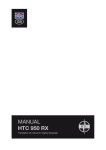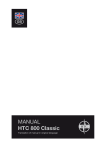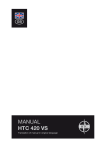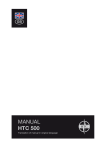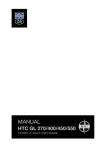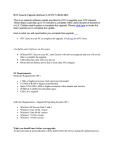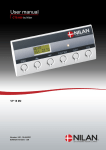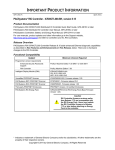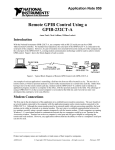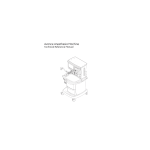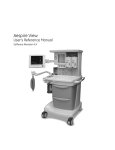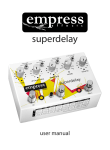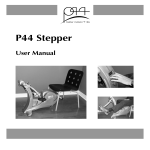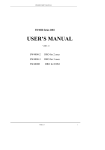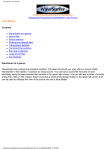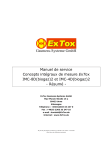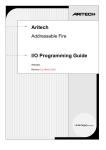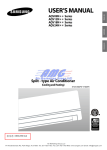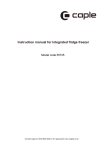Download Operator Manual
Transcript
GB MANUAL HTC 650 RX Translation of manual in original language Contact Information HTC Sweden AB Box 69 SE-614 22 Söderköping - Sweden Tel: +46 (0) 121-294 00 Fax: +46 (0) 121-152 12 You can find addresses for our retailers and service partners on our website: www.htc-floorsystems.com Always specify the model and serial number when asking questions about your product. Trademarks HTC is a trademark owned by HTC Sweden AB. Other names and products mentioned in this manual may be registered trademarks owned by the relevant companies. © 2007 HTC Sweden AB. All rights reserved. EC Declaration of conformity Manufacturer: HTC Sweden AB Box 69 SE-614 22 Söderköping Sweden +46 (0)121-29400 Type of equipment: Grinding machine Make: HTC Model: HTC 650 RX Year of manufacture: See machine name plate Serial number: See machine name plate As the manufacturer, we hereby declare under our sole responsibility that the above product with serial numbers from 2004 onward conforms to the applicable regulations in directives MD 2006/42/EC, EMC 2004/108/EC and LVD 2006/95/EC. The following standards have been used as a basis: ISO 5349-1:2001, ISO 5349-2:2001, ISO 20643:2005, ISO 3741. This product was CE-marked in 2009. The technical documentation is available from the manufacturer. Original of the EC declaration of conformity (Swedish). Other languages are translations of the original of the EC declaration of conformity. Söderköping, 01-01-2010 Peter Lundgren Development Manager, HTC Sweden AB Kåre Kilgren Product Manager, HTC Sweden AB HTC 650 RX 1 2 3 Table of contents Introduction 1 1.1 General ............................................................................ 1.2 Responsibility .................................................................. 1.3 Manual ............................................................................. 1.3.1 Safety instructions – Explanation of symbols ..... 1.4 Transportation ................................................................. 1.5 On delivery ...................................................................... 1.6 Unpacking the machine ................................................... 1.7 Machine name plate ........................................................ 1.8 Handling and storage ...................................................... 1.9 Vibration and noise .......................................................... 1.9.1 Hand and arm vibrations .................................... 1.9.2 Sound pressure level .......................................... 1 1 1 1 2 2 3 3 4 4 4 5 Safety 6 2.1 General Information ......................................................... 2.2 Warnings ......................................................................... 2.3 Notes ............................................................................... 6 6 7 Machine description 9 3.1 General machine description ........................................... 9 3.2 Description of controls – Control panel ........................... 11 3.3 Description of controls – Radio control unit ..................... 13 i Table of contents 4 Usage 15 4.1 4.2 4.3 4.4 4.5 4.6 15 16 17 18 20 21 22 23 23 24 25 25 25 25 26 26 27 27 28 28 29 29 4.7 4.8 4.9 4.10 4.11 5 ii HTC 650 RX General Information ......................................................... Handle settings ................................................................ Wheel locking .................................................................. Handling weights ............................................................. Access to grinding tools .................................................. Fitting and replacing grinding tools .................................. 4.6.1 Fitting grinding tools ........................................... 4.6.2 Changing grinding tools ...................................... Preparations for dry grinding ........................................... Preparations for wet grinding .......................................... Manoeuvring via the control panel .................................. 4.9.1 Standby .............................................................. 4.9.2 Emergency stop switch ...................................... 4.9.3 Start the machine - Manual driving ..................... 4.9.4 Overload ............................................................. Manoeuvring via the radio control panel ......................... 4.10.1 Standby .............................................................. 4.10.2 Start the Machine - Radio Control ...................... 4.10.3 Stop the machine - Radio control ....................... 4.10.4 Changing the radio frequency ............................ 4.10.5 Interrupted radio communication ........................ Making operation easier .................................................. Maintenance and repairs 31 5.1 5.2 5.3 5.4 5.5 5.6 5.7 5.8 31 31 31 32 32 32 33 33 General Information ......................................................... Cleaning .......................................................................... Charging/replacing the radio control unit's batteries ....... Daily ................................................................................ Every week ...................................................................... Every month (or 100 hours) ............................................. Repairs ............................................................................ Spare parts ...................................................................... HTC 650 RX 6 7 Table of contents Faultfinding 34 6.1 General Information ......................................................... 6.1.1 The machine will not start ................................... 6.1.2 The machine vibrates or wears the tool unevenly ............................................................. 6.1.3 The machine is grinding at an angle .................. 6.1.4 The machine stops - manual operation .............. 6.1.5 The machine stops - radio control ...................... 6.1.6 The fuses trip frequently ..................................... 6.1.7 The machine cannot cope .................................. 34 34 Electronic error codes 36 34 34 34 34 35 35 7.1 General Information ......................................................... 36 7.2 Resetting the frequency converter .................................. 37 8 Technical data 38 9 Environment 40 10 Warranty and CE marking 41 10.1 Warranty .......................................................................... 41 10.2 CE marking ...................................................................... 41 iii Table of contents iv HTC 650 RX HTC 650 RX 1 Introduction 1.1 General Introduction HTC 650 RX(R = Radio control, X = Four grinding discs) is a grinder that can be used to grind, strip, clean and polish concrete, natural stone and terrazzo floors. The machine's area of application depends on the choice of tool. You can easily mount and replace the tool, thanks to the EZchange patented tool system. The radio control means the operator is not affected by any vibrations from the machine. Moreover, the grinding work is more effective since, for instance, emptying the dust separator and handling the cables can be done at the same time as the machine is grinding. Read the manual carefully, so you are totally familiar with the machine before you start to use it. Contact your local retailer for further information. For contact information, see Contact Information at the start of the manual. 1.2 Responsibility Even though every effort has been made to make this manual as complete and accurate as possible, we bear no responsibility for incorrect or missing information. HTC reserves the right to change descriptions in this manual without giving prior notice. This manual is protected by the Copyright Act and no part of it may be copied or used in any other way without the written approval of HTC. 1.3 Manual In addition to the general functions, this manual deals with the areas of application and the maintenance of the grinder. 1.3.1 Safety instructions – Explanation of symbols A number of symbols are used in the manual to highlight the most important sections, see below. In order to avoid both personal injury and material damage as far as possible, it is extremely important to read and understand the text next to these symbols particularly carefully. There are other symbols indicating practical tips. These are to help you use the machine in the easiest and most effective way. The following symbols are used in the document to indicate where special attention is needed. 2.0 1 Introduction HTC 650 RX Warning! This symbol means Warning! and indicates that incorrect use can result in material damage to the machine or accessories. If you see this symbol next to a section of text, you must be particularly careful when reading through the text and not carry out any stages of which you are unsure. This is to protect you and other users and to avoid damaging the machine or other equipment. Note! This symbol means Note! and indicates that material damage can occur if the machine or its accessories are used incorrectly. If you see this symbol next to a section of text, you must be particularly careful when reading through the text and not carry out any stages of which you are unsure. This is to avoid damage to the machine or other equipment. Tip! This symbol means Tip! and indicates that you can get tips and advice on ways to make operating your machine or associated equipment easier, and to avoid wear. When you see this symbol you should read the accompanying text to facilitate your work and increase the service life of the machine. 1.4 Transportation Note! The machine cannot be moved manually if the drive wheels are locked and the radio control activated. Warning! Never deactivate the radio control function when you have stopped the machine on a sloping surface during loading, since the machine can start to roll. The machine is best transported securely fastened to a pallet. The machine can also be transported by lifting equipment, for example truck of crane, using the lifting eyes provided. In which case, make sure that the weights are locked in the forward position and that the handle is in its back position, see Figure 4-5, page 19 and Figure 4-2, page 17. 1.5 On delivery The following items are included in the delivery. Contact you retailer if anything is missing. 2 2.0 HTC 650 RX 1.6 Introduction • Grinding machine • Manual • Locking key for control cabinet • Start key • Hammer EZ system • Splash guard • The radio control unit Unpacking the machine Warning! Read through the safety instructions and the manual carefully before use. • • 1.7 Check carefully to see if the packaging or machine has been damaged during delivery. If there is any sign of damage, contact your retailer and report it. Report packaging damage to the transport company as well. Check that the delivery matches the order. If there are any discrepancies, contact your retailer. Machine name plate The machine name plate provides the following information. The model and serial number must be specified when ordering spare parts for the machine. Figure 1-1. Machine name plate 2.0 3 Introduction 1.8 HTC 650 RX 1. Model 2. Model number 3. Serial number 4. Year of manufacture 5. Power (kW) 6. Voltage (V) 7. Current (A) 8. Frequency (Hz) 9. Rotational speed (r.p.m.) 10. Weight (kg) 11. Address field Handling and storage The machine should be stored in a dry, warm location when not in use. Otherwise it may become damaged by condensation and coldness. 1.9 Vibration and noise Warning! Always use ear muffs when using the machine. 1.9.1 Hand and arm vibrations Hand and arm weighted vibration level [m/s²] for HTC 650 RX have been measured with equipment approved according to ISO 5349-1:2001. The measurement uncertainty for the measurement apparatus has been measured as +/- 2%. The machine has been tested in accordance with ISO 5349-2:2001 and ISO 20643:2005 in order to identify the operations that contribute to the most frequent vibration exposures. At vibration levels > 2.5 m/s², the exposure time should be limited in accordance with the table below. For vibration levels > 5 m/s², immediate measures should be taken by the employer to ensure that the exposure time does not exceed the time specified in the table below. Identified work conditions Measured values [m/s²] Daily permitted exposure (number of hours) 4 Grinding/polishing 5,45 6,74 Floor preparation (T-rex) 5,49 6,63 2.0 HTC 650 RX 1.9.2 Introduction Sound pressure level This machine has been tested for noise in accordance with ISO 3741. For information on sound pressure levels, see the table in chapter Technical data, page 38. 2.0 5 Safety HTC 650 RX 2 Safety 2.1 General Information This chapter contains all the warnings and notes that should be considered for HTC 650 RX. 2.2 Warnings Warning! The machine may only be used or repaired by personnel who have received the requisite theoretical and practical training and who have read the user manual. Warning! Never use the machine in an environment with a risk of explosion or fire. Familiarise yourself with the fire-protection instructions for the working area and follow them. Warning! Secure the area around the working area. No unauthorised persons should be allowed within a 15-metre radius of the machine. If a loose object were to catch under the grinding head, this could be flung out and cause personal injury. Warning! Use protective equipment such as safety shoes, safety goggles, protective gloves, breathing mask and ear muffs. Warning! The machine must only be started with the grinding head down. The rotating disc must be touching the floor and the correct tool must be fitted. Warning! Read through the safety instructions and the manual carefully before use. Warning! Always use ear muffs when using the machine. Warning! During grinding, the tools become very hot. Tip the machine back and allow it to stand for a short while. Use protective gloves when removing the tools. Warning! Disconnect the electrical supply, when changing tools or repairing the machine. 6 2.0 HTC 650 RX Safety Warning! The machine must only be used and moved on level surfaces. There is a risk of crushing if the machine starts to roll. Warning! Connect the machine to an earth fault breaker. Warning! Do not clean the machine using a high-pressure washer. Otherwise moisture may penetrate electrical elements and damage the machine’s drive system. Warning! The operator must never leave the machine unattended. Warning! The machine may only be used when the splash guard is fitted. 2.3 Notes Note! The machine may only be used to grind and polish natural stone, terrazzo, concrete, or other materials stated in this manual or that are approved by HTC. Note! Only original tools and spare parts from HTC may be used for the machine. Otherwise neither the CE marking nor the warranty will be valid. Note! For the CE marking to be valid, the instructions in this manual must be followed. Note! The machine must only be lifted using the lifting eye intended for the purpose in accordance with the relevant instructions. Note! The machine should be stored in a dry, warm (plus degrees) location when not in use. Note! If the machine is stored in a cold (minus degrees) location, it must be placed in a warm (plus degrees) location for at least two hours before use. 2.0 7 Safety HTC 650 RX Note! The appropriated dust extractor must be used when dry grinding. Contact HTC for model recommendation. Note! The dust extractor's suction hose must be connected to the appropriate socket on the machine. Adjust the dust extractor to match the grinder's capacity. Note! Do not use the emergency stop switch to stop the machine, except in emergencies. Note! As long as the emergency stop switch is pressed in, the machine cannot be started. Reset by turning the switch 45° clockwise so that it pops out again. The machine can then be restarted. Note! After removing glue and wet grinding, always lift up the grinding heads so that they do not stick to the floor and damage machine components and the floor when restarting. 8 2.0 HTC 650 RX 3 Machine description 3.1 General machine description Machine description HTC 650 RXIs designed for grinding in large spaces. It is used to grind, coarse grind, prepare and polish concrete, natural stone and terrazzo floors or other materials specified in this manual or material recommended by HTC. The machine is a perfect choice for removing coverings and grinding of concrete floors according to the HTC Superfloor method, which is an environmentally-friendly method for grinding and polishing concrete floors. Thanks to the fact the machine can be operated with the help of radio control, the work is significantly simplified and the grinding time lengthened. Furthermore, the work is more effective, since the discharging of the dust separator can be performed while the machine is radio controlled. The machine is constructed from a number of main components, see Figure 3-1, page 10 and Figure 3-2, page 11. Since it is equipped with four grinding discs, the machine is balanced and easy to use, which results in more efficient stripping and better grinding results. It also has an integrated weight system for adjusting the grinding pressure, which makes the machine perfect for those with high demands for flexibility. The handle can be set in a number of different tilt positions. Choose a position that suits you best, when you want to operate the machinery manually. The grinding cover has a connection for an external suction hose used for dry grinding. The machine can easily be equipped with a large number of tools, depending on the material to be ground. For the different tools, see HTC’s Product Catalogue under the Grinding Guide tab. HTC 650 RX can be equipped with a Mist Cooler system for effective cooling of the grinding tools. This system enables a very fine water mist to be diffused through a nozzle onto the floor surface, which cools the tools, making the grinding more effective. 2.0 9 Machine description HTC 650 RX Figure 3-1. The front of the machine 10 1. Handle 2. Handle lock 3. Lifting eye 4. Splash guard 5. Grinding cover 6. Wheels 7. Locking pin 8. Weight 9. Water tank 2.0 HTC 650 RX Machine description Figure 3-2. The machine's rear 3.2 1. Control panel 2. Electrical connection 3. Extraction connection 4. Hour counter 5. Control cabinet 6. Motor Description of controls – Control panel The picture below shows the machine's control panel: 2.0 11 Machine description HTC 650 RX Figure 3-3. Control panel 1. Power - Standby indicator: Indicates that the machine's functions have been activated. Shines with a green glow when the start key (9) is turned to the right (On). 2. Overload - Overload indicator: Lights up to indicate that the machine is using too much power. If this is ignored, the power supply to the motor will be interrupted and an error code generated. 3. Com Error - Communication error indicator: Lights when there is a communication error between the grinding machine and the radio control unit. 4. Radio Enabled - Radio control indicator: Lights when the knob "Radio On/Off" is turned to the right (On). 5. Radio On/Off - Turn the knob to the right, when the grinding machine is to be manoeuvred via radio control. 6. Speed - Rotation speed: Regulates the rotational speed of the machine’s grinding discs. This is only possible when the grinding discs rotation is started via the "Start/Stop" knob. 7. Start/Stop -Start/stop the grinding discs' rotation. Turn the knob to "Start" to start the rotation, turn the knob to "Stop" to switch off the rotation. 8. EM-Stop-Emergency stop switch: Press the switch in an emergency to cut the power to the machine. 9. On/Off - Start key to start/stop the machine's functions: Turn the key to the right (On) to activate the machine's functions and prepare for starting. Turn the knob to the left (Off) to switch off the machine's functions. When the machine is not to be used, the knob "Start/Stop" must always be turned to the Stop position and the knob "Radio On/Off" (5) is always turned to the Off position. The knob (5) being in the Off position is indicated by the "Radio Enabled" (4) indicator going out. 12 2.0 HTC 650 RX Machine description Note! Press the emergency stop switch (EM-Stop), if the machine accidentally starts to move to avoid personal injury and/or damage to the machine. 3.3 Description of controls – Radio control unit The picture below shows the machine's radio control unit: Figure 3-4. The radio control unit 2.0 1. STEERING - Control for steering the machine to the right (R) and left (L). 2. FREQ - Frequency button: Push the button to change the frequency of the radio control. 3. GRINDING SPEED (0 - 100%) - GRINDING SPEED (0 - 100%) - Regulates the rotational speed of the machine’s grinding discs. 4. ON/STOP - Start/stop the grinding discs' rotation. Move the control to ON to start the rotation, move the control to STOP to switch off the rotation. 5. Battery compartment - Holds the batteries that power the radio control unit. 6. EM-STOP - Breaks the radio contact between the radio control unit and the machine's receiver, which results in the machine stopping immediately. The radio control unit should be switched off when it is not in use. Can also be used to start/stop the radio control unit. Used in combination with the button "Start of radio communication". 7. SPEED (min - max) - Turn to adjust the machine's speed in the direction of movement. 8. FWD/RWD - Control for moving the machine forward (FWD) or backwards (RWD). 13 Machine description • 14 HTC 650 RX 9. OFFSET (L - R) - Turn the control to the left (L) or the right (R) to adjust for any tendency to veer. 10. Start of radio communication - Button to start the radio communication between the radio control unit and the machine's receiver. It is used together with the EM-STOP button. 11. Display/Channel Info - Two points blink alternately with a red light, when the radio control unit is activated. The displays also shows information on the radio channel and any error messages. The letter "L" appears and blinks rapidly, when the batteries need to be recharged/replaced. The radio control unit functions for about 30 min after the "L" appears for the first time. Take the radio control unit to a safe place when the "L" appears in the display and switch off the unit. Install two charged AA batteries 1.2 V NiMH, or alternatively two normal, non-rechargeable 1.5 V AA. For instruction on charging/replacement, see under Charging/replacing the radio control unit's batteries, page 31. 2.0 HTC 650 RX Usage 4 Usage 4.1 General Information The following section describes how to change tools and how to operate the grinding machine. This section does not deal with the technical aspects of grinding, such as selection of grinding tools, etc. For choice of tools, see HTC’s Product Catalogue under the Grinding Guide tab. Warning! The machine may only be used or repaired by personnel who have received the requisite theoretical and practical training and who have read the user manual. Warning! Never use the machine in an environment with a risk of explosion or fire. Familiarise yourself with the fire-protection instructions for the working area and follow them. Warning! Secure the area around the machine. No unauthorised persons should be within a 15-metre radius of the machine. If loose objects get under the grinding head, these may be flung out and cause personal injury. Warning! Use protective equipment such as safety shoes, safety goggles, protective gloves, breathing mask and ear muffs. Warning! The machine must only be started with the grinding head down. The rotating disc must be touching the floor and the right tool must be fitted. Warning! The machine must only be used and moved on level surfaces. There is a risk of being clamped if the machine should start to roll. Warning! The operator must never leave the machine unattended. Tip! Check the minimum recommended cable area before using an extension cord. You will find the recommended cable area under Technical data, page 38. 2.0 15 Usage 4.2 HTC 650 RX Handle settings The appropriate working height is set with the help of the adjustable handle. The handle is locked with the handle lock on the handle cover, see Figure 4-1, page 16. Figure 4-1. Locking the handle 1. Loosen the handle by turning the handle lock to the left or the right. 2. Move the handle to the desired position, the handle locks automatically in the desired position. 16 2.0 HTC 650 RX Usage 3. Make sure that the handle lock returns to the original position to guarantee that the handle is locked properly. Figure 4-2. The handle's position 1. Working position - always used when operating manually. It can also be used when driving via the radio control unit. 2. Rear position - used for tipping the machine to make tool replacement easier. It can also be used to advantage when driving the machine via the radio control unit. 3. The forward position - used, for instance, for transportation, as the machine takes up significantly less space. Lock the handle in the desired position, using the handle lock, see Figure 4-1, page 16. 4.3 Wheel locking The machine is equipped with a locking mechanism on each wheel, see the driving lock in Figure 3-2, page 11. The driving lock is used to release and decouple the machine's wheels from their drive motors, which are located in the drive motor box, see Figure 3-2, page 11. In the locked position, the drive motors are connected to the wheels, this means that the machine can only be moved by using the drive motors via the operating panel or the radio control unit 2.0 17 Usage HTC 650 RX • Decouple the wheels by pulling the locking pin straight out, see Figure 4-3, page 18. Figure 4-3. Decouple the wheels • Turn the locking pin 90 and release it for the secured position, see Figure 4-4, page 18. Figure 4-4. Turn 90 degrees In order to couple the wheels to the drive motors, the same steps as above are carried out. Tip! During faultfinding, the wheels can be decoupled from the motors and test driven without the machine moving. 4.4 Handling weights The machine is equipped with two weights to make it easy to move the machine's centre of gravity. Each weight is provided with two locking pins with which the weights can be lowered and locked in three positions; forward, up (normal position) and backwards. • 18 Pull each pin out and lock in the extracted position by turning in the direction of the arrow, see Figure 4-5, page 19. 2.0 HTC 650 RX Usage Tip! We recommend that the weights are folded up during grinding, since if the grinding pressure is too high and the tool is wrong, it can cause damage to the machine and the floor. Warning! There is a risk of crush injuries when the weights are folded back, since these are not locked in this position. To obtain a greater grinding pressure, and thereby increased grinding effect, the weights are lowered forwards, see Figure 4-5, page 19. Figure 4-5. Weights lowered forwards During normal grinding as well as during transport of the machine, the weights should be placed in the up position, see Figure 4-6, page 19. Figure 4-6. Weights in the up position During the exchange of tools and when tools with a high removal rate (T-Rex™) are used, the weights should be folded back, see Figure 4-7, page 20. 2.0 19 Usage HTC 650 RX Figure 4-7. Weights folded back 4.5 Access to grinding tools Warning! The tool becomes very hot during use. Tip the machine back and allow it to stand for a short while. Use protective gloves when removing the tools. Warning! Disconnect the electrical supply, when changing tools or repairing the machine. 1. Set the handle to the rear position - see Figure 4-2, page 17 2. Fold the weights back and place a foot against one of the weights, see Figure 4-8, page 20. Figure 4-8. Foot on weight 20 2.0 HTC 650 RX Usage 3. Tip the machine backwards carefully, until the weights reach the floor, see Figure 4-9, page 21. Figure 4-9. Weights on the floor 4. Tip the machine further back, until all of the machine reaches the floor, see Figure 4-10, page 21. Figure 4-10. Machine on the floor 4.6 Fitting and replacing grinding tools Warning! Disconnect the electrical supply, when changing tools or repairing the machine. Warning! The tool becomes very hot during use. Tip the machine back and allow it to stand for a short while. Use protective gloves when removing the tools. As the machine is equipped with the patented EZchange tool system, fitting and replacing grinding tools is quick and easy. The tool system consists of wings on which diamond grinding tools are fitted without the need for screws. 2.0 21 Usage 4.6.1 HTC 650 RX Fitting grinding tools 1. Slide the grinding tool diagonally, from above, down into the appropriate guide slot on the tool holder, see Figure 4-11, page 22. Then push the tool fully into the guide slot. Figure 4-11. Fitting grinding tools 2. Lock the grinding tool into the tool holder by giving it a few light taps with a rubber hammer - see Figure 4-12, page 22. Figure 4-12. Locking grinding tools 22 2.0 HTC 650 RX 4.6.2 Usage Changing grinding tools 1. Remove the grinding tool by giving it a few light taps with a rubber hammer so the locking mechanism releases, see Figure 4-13, page 23. Then draw the tool up out of the guide slot. Figure 4-13. Removing grinding tools 2. Slide the grinding tool diagonally, from above, down into the appropriate guide slot on the tool holder, see Figure 4-11, page 22. Then push the tool fully into the guide slot. 3. Lock the grinding tool into the tool holder by giving it a few light taps with a rubber hammer - see Figure 4-12, page 22. 4.7 Preparations for dry grinding Warning! Check that the splash guard is fitted. 2.0 23 Usage HTC 650 RX 1. Connect a dust extractor to the machine. For dust extractor models, see under the Suction System tab in the HTC Product Catalogue. Note! The dust extractor's suction hose must be connected to the appropriate socket on the machine. Adjust the dust extractor to match the grinder's capacity. 2. Inspect the floor carefully and remove any objects sticking up, such as reinforcement rods or bolts, and any debris that could get caught in the machine. 3. Attach the appropriate tool to the machine, see under Fitting grinding tools, page 22 4. Set the handle to the working position, see Figure 4-2, page 17. 4.8 Preparations for wet grinding Warning! Check that the splash guard is fitted. 1. Always use liquid suction when wet grinding. Tip! Never use a dust extractor, as blockages may develop in the dust extractor's suction hose and filter. 2. Inspect the floor carefully and remove any objects sticking up, such as reinforcement rods or bolts, and any debris that could get caught in the machine. 3. Attach the appropriate tool to the machine. 4. Set the handle to the working position, see Figure 4-2, page 17. Warning! Only use cold water with no chemical additives. 5. Connect the water hose to the water connection. 6. Turn the tap on the machine on to start the water supply. 7. Turn in the opposite direction to turn the water off. 24 2.0 HTC 650 RX 4.9 Usage Manoeuvring via the control panel Tip! Drive the machine manually in difficult to navigate spaces. During manual driving, the operator pushes the machine forwards across the floor surface and manoeuvres it via the control panel, see Figure 3-3, page 12. 4.9.1 Standby To activate the machine's functions, turn the start key to the right. When the key is in this position, the Power green indicator light on the control panel is lit, indicating that the machine is in standby mode. 4.9.2 Emergency stop switch The emergency stop switch, (EM-Stop) must only be used in an emergency. When the switch is pressed, all electrically-powered equipment on the machine are turned off. Note! Do not use the emergency stop switch to stop the machine other than in emergencies, as it decreases the lifespan of the machine's electrical components. Note! As long as the emergency stop switch (EM-Stop) is pressed, the machine cannot be started. Reset by turning the switch 45° so that it pops out again. The machine can then be restarted. 4.9.3 Start the machine - Manual driving For a description of the control panel, see Figure 3-3, page 12. 1. Make sure the emergency stop switch has not been activated. 2. Check that the wheel lock is decoupled from the wheel before operating, see Figure 4-3, page 18. 3. Insert the cable. 4. Start the dust separator if dry grinding is to be done. 2.0 25 Usage HTC 650 RX 5. Turn the start key to the right "On". 6. Start the grinding discs rotation by turning the knob to "Start". 7. Set the speed for the grinding discs using the Speed knob. 8. The machine has now started. 4.9.4 Overload If the machine is using too much power, the Overload indicator on the control panel goes off. The machine switches off automatically after a while if this is ignored. Reduce the speed of the grinding discs to see if the Overload indicator goes out. If this does not help, follow the procedure for troubleshooting. Tip! If the machine is heavy to operate, it can be due to the placing of the weights. Fold the weights up or back, to unload the grinding head, see Figure 4-6, page 19 and Figure 4-7, page 20. 4.10 Manoeuvring via the radio control panel During radio control, the machine is manoeuvred via the radio control unit, see Figure 3-4, page 13. Warning! Never leave the machine unattended when operating via the radio control unit. When operating via the radio control unit, the machine is driven forwards with the help of the motors in the drive motor box. From a work environment perspective, operation via the radio control unit is recommended. The radio control unit and the machine are individually paired, which means that only the intended unit can control a machine. The identification code can be seen on the machine sign and on the radio control unit. 26 2.0 HTC 650 RX Usage 1. Loosen the battery cover on the radio control unit by screwing loose the screws on the cover. 2. Place two charged AA batteries 1.2 V NiMH, or alternatively two normal, non-rechargeable 1.5 V AA batteries in the battery space. Note! Rechargeable batteries must be fully charged before they are used for the same time. Warning! Never attempt to charge standard, non-rechargeable 1.5 AA batteries. 3. Close the cover and fasten it in place with the screws. • 4.10.1 Check that the wheel lock is secured between the wheel and the drive motor, see Figure 4-4, page 18. Standby To activate the machine's functions, turn the start key to the right "On". When the key is in this position, the Power green indicator light on the control panel is lit, indicating that the machine is in standby mode. 4.10.2 Start the Machine - Radio Control Note! To save energy, the radio control unit automatically switches off if a button is not activated within a given time. in which case, the blinking points in the display are extinguished. 1. Turn the knob "Radio On/Off" on the control panel to the right, to prepare the machine for manoeuvring via the radio control unit, the indicator "Radio Enables" on the control panel lights up. 2. Press the button "EM-STOP" and then press the button to start the radio communication on the radio control unit to activate the radio control. The buttons can be activated in any order, but after you have pressed the first button the second must be pressed within 5 seconds. When the radio control is activated, the two points start blinking alternately with a red light on the control unit's display. 2.0 27 Usage HTC 650 RX 3. Zero the radio control unit by doing the following: - Turn the knob for speed (SPEED) to "min". - Set the control for driving forwards/backwards (FWD/RWD) in the middle position. - Turn the knob for the rotational speed (GRINDING SPEED) to 0%. - Move the control for starting and stopping the grinding discs' rotation (ON/STOP) to STOP. 4. Press the button to start radio communication. The communication error indication (ComError) on the machine's control panel should then go out. 5. Start the grinding discs rotation by moving in the control "ON/STOP" to ON. Adjust the rotational speed with the knob "GRINDING SPEED". 6. Start the machine's drive motors by moving the control "FWD/RWD" to FWD. Adjust the speed with the knob "SPEED". • 4.10.3 Check the wheel's locking, if the machine does not move, see instructions under Wheel locking, page 17. Stop the machine - Radio control 1. Turn the knob for speed (SPEED) to "min". 2. Set the control for driving forwards/backwards (FWD/RWD) in the middle position so the machine stops. 3. Turn the knob for the rotational speed (GRINDING SPEED) to 0%. 4. Move the control for starting and stopping the grinding discs' rotation (ON/STOP) to STOP. 5. Press in the button "EM-STOP", to switch off the radio control unit. 4.10.4 Changing the radio frequency If several machines are used in the same workplace, there can be interference with the radio communication, which means that it is necessary to change the frequency on a machine. It can also be necessary to change the radio frequency, if other equipment that is used in the workplace causes interference with the radio communication. Change the frequency, by doing the following: 28 2.0 HTC 650 RX Usage 1. Stop the machine, for how this is done see under Stop the machine - Radio control, page 28. 2. Press and hold in the button to start radio communication. 3. Press on the frequency button "FREQ". The machine's radio receiver automatically searches for the new frequency, the number of the selected frequency channel is shown briefly on the radio control unit's display. Press on the frequency button "FREQ" to see the selected frequency channel while operating. Note! If the error code "Jt" is shown on the display, immediately contact the HTC Service Centre for instructions. 4. Release the button to start radio communication. 5. Start the machine, for how this is done see under Start the Machine - Radio Control, page 27. 4.10.5 Interrupted radio communication If the distance between the machine and the radio control unit becomes too great, the radio communication will be broken and the machine stops. In order to restart operation via the radio control unit, follow the instructions under Start the Machine - Radio Control, page 27. 4.11 Making operation easier In order to keep the suction hose for the dust extractor and the power cable out of the working area and/or path of the machine, the hose and cable can be arranged as shown in the picture below. 2.0 29 Usage HTC 650 RX Figure 4-14. Making operation easier Tip! By arranging the hose and cable as shown in the picture, you avoid disruptive stoppages caused by having to re-position the cable and hose. 30 2.0 HTC 650 RX Maintenance and repairs 5 Maintenance and repairs 5.1 General Information We recommend regular inspections of all seals. Warning! Disconnect the electrical supply, when changing tools or repairing the machine. Warning! Use protective equipment such as safety shoes, safety goggles, protective gloves, breathing mask and ear muffs. Warning! During electro-welding work on the machine, the radio receiver must always be disconnected to avoid damage to the receiver's electrical system. 5.2 Cleaning Warning! Do not clean the machine using a high-pressure washer. Otherwise moisture may penetrate electrical elements and damage the machine’s drive system. 5.3 • Vacuum the electrical cabinet, if required. • Always clean the machine after use with a damp sponge or cloth. Charging/replacing the radio control unit's batteries Warning! Do not expose the batteries to naked flames since this could cause an explosion. • Recharge/replace the batteries when L" appears in the display and blinks quick, see Figure 3-4, page 13. Procedure: 1. Stop the machine, see under Stop the machine - Radio control, page 28. 2. Loosen the battery cover by screwing the screws out on the cover 3. Remove the old/flat batteries. 2.0 31 Maintenance and repairs HTC 650 RX 4. Replace with the new/charged batteries. 5. Close the cover and fasten it in place with the screws. 6. Start the machine, see under Start the Machine - Radio Control, page 27. 5.4 Daily • Wash the machine, if it is used for wet grinding or with the Mist Cooler system. • Check for wear to the grinding tool – abnormal or uneven wear may indicate a damaged grinding holder. Check the tool holder and grinding holder to ensure that no damage or cracks have arisen. Replace the parts if there is any damage. Remove any residues of building material from the radio control unit. • • 5.5 Every week • Wash the machine. • Check the grinding holders. Remove the tools and run the machine in mid air at the slowest speed. If the grinding holders oscillate or wobble significantly, they are damaged. Check that the upper belt is whole, by turning the large disc in one direction or the other. If there is resistance the belt is whole, if the disc rotates freely the belt is broken. • Tip! Recondition all the grinding holders at the same time. 5.6 32 Every month (or 100 hours) • Tighten anything that may have vibrated loose. • Remove the grinding cover and check that it is undamaged. • Check the upper belt and replace if necessary. • • Check the seals on the shafts on which the upper belt runs and replace if necessary. Scrape and vacuum-clean the parts shielded by the grinding cover. • Test run and listen for any dissonance from the bearings. 2.0 HTC 650 RX 5.7 Maintenance and repairs • Clean or, if necessary, replace the filter to the electrical cabinet. • Check the functioning of the radio control unit's ME-STOP button. • Check the parts that wear on the radio control unit, e.g. the dust cover. Repairs Any repairs that may be required must be carried out by a HTC Service Centre, which has trained service personnel and uses HTC original parts and accessories. Contact your retailer if your machine requires servicing. For contact information, see Contact Information at the start of the manual. 5.8 Spare parts To ensure rapid delivery of spare parts, always specify the model, the machine's serial number and the spare part number when ordering. Information on the model and serial number can be found on the machine's name plate. Information on spare part numbers can be found in the machine's spare parts list which is available to read or print out from the accompanying digital media or HTC's website: www.htc-floorsystems.com Only original tools and original spare parts from HTC may be used. Otherwise neither the CE marking nor the warranty will be valid. 2.0 33 Faultfinding HTC 650 RX 6 Faultfinding 6.1 General Information This chapter describes some of the faults that may occur and how to deal with these faults. If the fault cannot be dealt with, or if there are other faults, contact your nearest retailer. See Contact Information at the front of the manual. 6.1.1 The machine will not start • • • • 6.1.2 • • • Check the condition of the grinding holders. If the grinder holders need reconditioning, contact HTC for information about spare parts. Recondition the grinding holder. See under The machine vibrates or wears the tool unevenly, page 34. Check that the upper belt is undamaged. Try to turn the large disc in one direction or the other, there should be resistance. If it turns freely, the belt is broken and must be replaced. The machine stops - manual operation • 6.1.5 Check that there is movement between the chassis and grinding head. If necessary, loosen one of the two pins in order to increase the play between the chassis and the grinding head. Check the belts, replace if necessary. The machine is grinding at an angle • 6.1.4 Check the error code on the frequency converter's display. For corrective measures, see Electronic error codes, page 36. The machine vibrates or wears the tool unevenly • 6.1.3 Check if the emergency stop switch on the control panel is pressed. Reset the switch by turning it 45°. Check if the power connection is correct. Check that there is full voltage available on the supply's phase/phases. Check the fuses and contactors in the electrical cabinet. Check the error code in the display on the frequency converter, see Electronic error codes, page 36. The machine stops - radio control Other equipment can interfere with the radio traffic between the machine and the radio control unit, which means that the communication error indicator (ComError) can start 34 2.0 HTC 650 RX Faultfinding to blink on and off. When the contact between the machine and the radio control has been broken for too long the machine stops for safety reasons. 6.1.6 • Check if the communication error indicator (ComError) blinks. • Restart the machine and switch off any interfering equipment. • Check the error code in the display on the frequency converter, see Electronic error codes, page 36. The fuses trip frequently • • 6.1.7 The load is too high on the distribution box to which the machine is connected. Use a different socket or reduce the speed of the machine. Check the tools. Ensure that the correct tools are used, that they are in working order and that they are correctly fitted. The machine cannot cope • • • • Heavy load. Press the handle down slightly so that the grinding head eases slightly away from the surface being ground. Sticky coating on the surface being ground. Run half of the machine on the surface to be cleaned and half on the clean surface. This removes any residue from the tools. Check the tools. Ensure that the correct tools are used, that they are in working order and that they are correctly fitted. Voltage drop. Check that the cable area meets HTC’s recommendations. Tip! Check the minimum recommended cable area before using an extension cord. You will find the recommended cable area under Technical data, page 38. 2.0 35 Electronic error codes HTC 650 RX 7 Electronic error codes 7.1 General Information In the event of an error, the error code is shown in the display. The most common error codes that may occur on the frequency converter, in the control cabinet, are listed below. In the event of other errors, contact the HTC Service Centre. Code Cause Action 0001 Excess current Review tool selection. Reduce the grinding speed. Check that the grinding head/drive motor are moving freely. Check the motor cable and connector. Check the motor. 0002 Excess voltage Check if the power supply is showing static or transient excess voltage. 0003 Excess temperature in the converter Check the cabinet cooling system. Ensure that the cabinet is clean. Check the converter's cooling fan. Clean the filter. 0004 Short circuit in motor or motor cable Check the motor cable and connector. Check the motor. 0006 Under-voltage Check the feed fuse and the mains fuse. Check the cable dimension and length. 0009 Motor temperature too high due to overload Check that the grinding head/drive motor are moving freely. Check the motor's cooling flanges and fan. 0010 Panel dropout Check panel connection. 0012 Locked motor Check that the grinding head is moving freely. 0016 Earth fault Check the motor cable and connector. Check the motor. 0022 Phase failure on supply in Check supply fuses. Check if there is a lack of symmetry in the mains supply. 0034 Phase failure in motor Check the motor cable and connector. Check the motor. 2001 Output current limiter active Check that the grinding head/drive motor are moving freely. Check the motor cable and connector. Check the motor. 2008 Communication fault, panel Check panel connections. 2009 Excess temperature in the converter Check the cabinet cooling system. Ensure that the cabinet is clean. Check the converter's cooling fan. Clean the filter. 36 2.0 HTC 650 RX Electronic error codes Code Cause Action 2010 High motor temperature Check that the grinding head/drive motor are moving freely. Check the motor's cooling flanges and fan. 2012 The motor is operating in the locking range Check that the grinding head/drive motor are moving freely. 7.2 Resetting the frequency converter 1. Switch off the machine by turning the start key to "Off" and waiting for 10 seconds. 2. Start the machine by turning the start key to "On". 2.0 37 Technical data 8 HTC 650 RX Technical data The table below shows the machine’s technical data. HTC 650 RX HTC 650 RX EU Mist US Mist Motor 11 kW 11 kW Current 25 A 25 A Tension 3 x 380-415 V 3 x 440-480 V LEDs 24 V 24 V Control current 24 V 24 V Total machine weight 448 kg 448 kg Chassis weight 236 kg 236 kg Weight, grinding head 212 kg 212 kg Weights 2 x 32 kg 2 x 32 kg Grinding diameter 680 mm 680 mm Grinding pressure, weights lowered forwards 248 kg 248 kg Grinding pressure, weights in the up position 172 kg 172 kg Grinding pressure, weights folded backwards 154 kg 154 kg RPM 373 - 1679 r.p.m 373 - 1679 r.p.m Water tank 19 litres 19 litres Grinding discs 4 x 230 mm 4 x 230 mm Recommended minimum cable area 6 mm² 6 mm² Sound pressure level, average value over time according to ISO 3741, 96 dBA measurement uncertainty according to class 1 measuring instruments for sound level meters. 38 96 dBA 2.0 HTC 650 RX Technical data Figure 8-1. Height and length of the machine in millimetres Figure 8-2. Width of the machine in millimetres 2.0 39 Environment 9 HTC 650 RX Environment HTC's products are constructed mainly of recyclable metal and plastic. The main materials used are listed below. Chassis Frame Electro-galvanised steel Handle Plastic covered steel Wheels Polyurethane-filled rubber wheels Cover ABS plastic Motor Aluminium Grinding head Lower cover Aluminium Cover ABS plastic External plate and steel components Electro-galvanised steel Other components Steel Electrical system Control cabinet Stainless steel Cables Copper conductors with PVC covering Plastic components can be recycled by sorting as hard plastics. Electronics can be deposited as electronic waste. The machine or machine components can also be returned to HTC Sweden AB. For recycling and scrapping of components, see the applicable national regulations for each country. 40 2.0 HTC 650 RX 10 Warranty and CE marking 10.1 Warranty Warranty and CE marking This warranty only covers manufacturing defects. HTC bears no responsibility for damage that arises or occurs during transportation, unpacking or use. In no instance and under no circumstances shall the manufacturer be held responsible for damage and defects caused by incorrect use, corrosion or use outside the prescribed specifications. The manufacturer is not responsible for indirect damage or costs under any circumstances. For complete information on the manufacturer's warranty period, see HTC's current warranty terms. Local distributors may have special warranty terms specified in their terms of sale, delivery and warranty. If there is any uncertainty regarding warranty terms, please contact your retailer. 10.2 CE marking CE marking of a product guarantees its free movement within the EU area in accordance with EU regulations. CE marking also guarantees that the product fulfils various directives (the EMC Directive and other possible requirements in so-called directives for new procedures in accordance with these regulations). This machine carries the CE mark in accordance with the Low Voltage Directive (LVD), the Machinery Directive and the EMC Directive. The EMC Directive states that electrical equipment must not disturb its surroundings with electromagnetic radiation and that it must also be immune to electromagnetic interference in the surroundings. This machine is classified for use in environments such as heavy industry, light industry and homes. See the Manufacturer’s Declaration of Conformity, which shows that the machine is harmonised with the EMC Directive. 2.0 41

















































